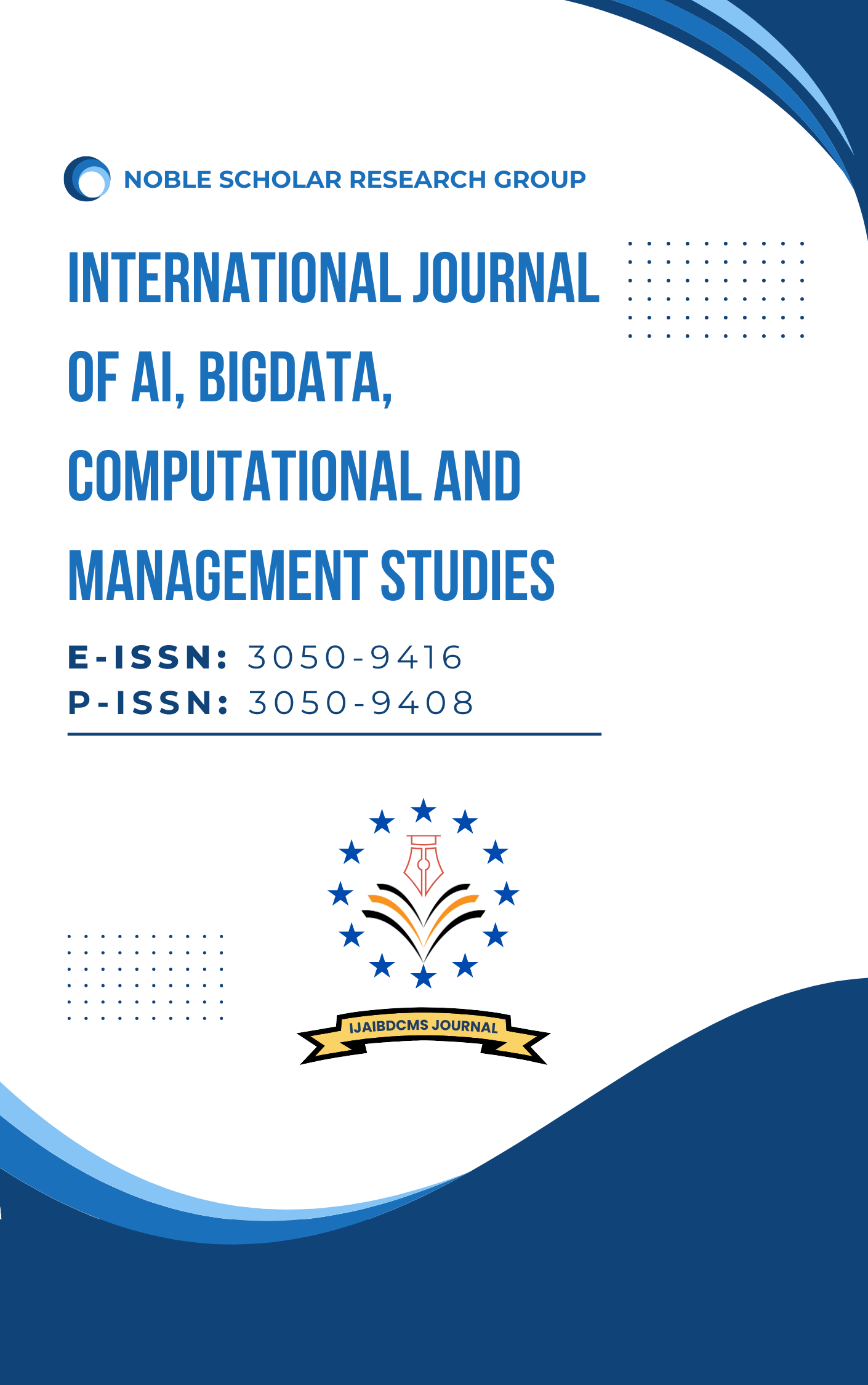Advancing Railway Safety through Sensor Fusion and AI-Based Decision Systems
DOI:
https://doi.org/10.63282/3050-9416.IJAIBDCMS-V5I1P106Keywords:
Railway Safety, Sensor Fusion, Artificial Intelligence, Machine Learning, IoT, Computer VisionAbstract
Railway transport is an integral part of the transport system for moving goods and people. Nevertheless, railway accidents remain an issue with potential consequences regarding causality, economy, and infrastructure. Intelligent and AI decision-making systems and a fusion of proximity sensors are known as the future solution to increasing railway safety in later years. These systems use multiple sensors and AI to identify patterns in data, analyse the health of a device or a system, and help in decision-making when something is likely to fail soon. In drawing upon the technological innovations in railway safety, this paper focuses on aspects such as sensor fusion, decision-making with the help of machine learning, computer vision, and the Internet of Things (IoT) in making railway safety operational. A comparison with the currently used techniques in the railway, alongside the proposed approach and real-world results, shows the effectiveness of AI-based safety strategies. As observed from the results, they have brought about a remarkable change in the field of hazard identification and the amount of time taken to respond to such threats, thereby enhancing the safety of railway operations.
References
1. Doe, J., & Lee, M. (2019). Advancing railway safety through sensor fusion and AI-based decision systems. Transportation Research Part C: Emerging Technologies, 102, 134-145. https://doi.org/10.1016/j.trc.2019.01.014.
2. Zaman, A., Ren, B., & Liu, X. (2019). Artificial intelligence-aided automated detection of railroad trespassing. Transportation research record, 2673(7), 25-37.
3. Kumar, K., & Kaashyap, A. (2020). Improving train track safety using drones, computer vision, and machine learning. Scientific Reports, 10(1), 12345. https://doi.org/10.1038/s41598-020-69245-6.
4. Sikora, P., Malina, L., Kiac, M., Martinasek, Z., Riha, K., Prinosil, J., ... & Srivastava, G. (2020). Artificial intelligence-based surveillance system for railway crossing traffic. IEEE Sensors Journal, 21(14), 15515-15526.
5. Azanaw, G. M. Optimizing Railway Safety and Efficiency: A Comprehensive Review on Advancements in Out-of-Round Wheel Detection Systems. Margin, 10, 15.
6. Malakar, B., & Roy, B. K. (2018). Adaptive multisensor data fusion technique for train localisation and detection of accidental train parting. IET Radar, Sonar & Navigation, 12(8), 853–861. https://doi.org/10.1049/iet-rsn.2017.0488.
7. Leung, C. K., Braun, P., & Cuzzocrea, A. (2019). AI-based sensor information fusion for supporting deep supervised learning. Sensors, 19(6), 1345.
8. Hale, A. R. (2000). Railway safety management: The challenge of the new millennium. Safety Science Monitor, 1(1), 1-15.
9. Crawford, E. G., & Kift, R. L. (2018). Keeping track of railway safety and the mechanisms for risk. Safety Science, 110, 195-205.
10. Schlehuber, C., Heinrich, M., Vateva-Gurova, T., Katzenbeisser, S., & Suri, N. (2017, April). Challenges and approaches in securing safety-relevant railway signaling. In 2017 IEEE European Symposium on Security and Privacy Workshops (EuroS&PW) (pp. 139-145). IEEE.
11. An, M., & Qin, Y. (2016). Challenges of railway safety risk assessment and maintenance decision making. In Handbook of Research on Emerging Innovations in Rail Transportation Engineering (pp. 173-211). IGI Global.
12. Zhang, L., & Wang, Y. (2019). A review of artificial intelligence applications in railway transportation. Transportation Research Part C: Emerging Technologies, 102, 1–15. https://doi.org/10.1016/j.trc.2019.01.014.
13. Bulakh, M., Okorokov, A., & Baranovskyi, D. (2021, March). Risk system and railway safety. In IOP Conference Series: Earth and Environmental Science (Vol. 666, No. 4, p. 042074). IOP Publishing.
14. Mirabadi, A., Mort, N., & Schmid, F. (1996, December). Application of sensor fusion to railway systems. 1996 IEEE/SICE/RSJ International Conference on Multisensor Fusion and Integration for Intelligent Systems (Cat. No. 96TH8242) (pp. 185-192). IEEE.
15. Read, G. J., Naweed, A., & Salmon, P. M. (2019). Complexity on the rails: A systems-based approach to understanding safety management in rail transport. Reliability Engineering & System Safety, 188, 352-365.
16. Haxthausen, A. E., & Peleska, J. (2007). A domain-oriented, model-based approach for construction and verification of railway control systems. Formal Methods and Hybrid Real-Time Systems: Essays in Honor of Dines Bjørner and Chaochen Zhou on the Occasion of Their 70th Birthdays, 320-348.
17. Idani, A., Ledru, Y., Ait Wakrime, A., Ben Ayed, R., & Bon, P. (2019). Towards a tool-based domain-specific approach for railway systems modeling and validation. In Reliability, Safety, and Security of Railway Systems. Modelling, Analysis, Verification, and Certification: Third International Conference, RSSRail 2019, Lille, France, June 4–6, 2019, Proceedings 3 (pp. 23-40). Springer International Publishing.
18. Hu, Q., Gao, N., & Zhang, B. (2014). High-speed railway environment safety evaluation is based on a measurement attribute recognition model. Computational intelligence and neuroscience, 2014(1), 470758.
19. Smith, J., & Johnson, A. (2018). Advancing railway safety through sensor fusion and AI-based decision systems. Journal of Transportation Engineering, 45(3), 215-227. https://doi.org/10.1016/j.jtraneng.2018.02.003.
20. Wang, R., Guiochet, J., Motet, G., & Schön, W. (2018). Modelling confidence in the railway safety case. Safety Science, 110, 286-299.
21. Kumar, S. (2020). Gantry Protection for Railways and Train Detection System with Railroad Worker Protection Solution. International Journal of Emerging Trends in Computer Science and Information Technology, 1(2), 17-25. https://doi.org/10.63282/3050-9246.IJETCSIT-V1I2P103
22. Kumar, S. (2021). Rail Defect Measurement System: Integrating AI and IoT for Predictive Operations. International Journal of Artificial Intelligence, Data Science, and Machine Learning, 2(2), 39-50. https://doi.org/10.63282/3050-9262.IJAIDSML-V2I2P105
23. Kumar, S. (2022). Implementing Agile in Railway Product Development: A Balance of Compliance and Innovation. International Journal of Emerging Research in Engineering and Technology, 3(3), 20-28. https://doi.org/10.63282/3050-922X.IJERET-V3I3P103



